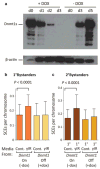Methyltransferases mediate cell memory of a genotoxic insult
- PMID: 21057543
- PMCID: PMC3044496
- DOI: 10.1038/onc.2010.480
Methyltransferases mediate cell memory of a genotoxic insult
Abstract
Characterization of the direct effects of DNA-damaging agents shows how DNA lesions lead to specific mutations. Yet, serum from Hiroshima survivors, Chernobyl liquidators and radiotherapy patients can induce a clastogenic effect on naive cells, showing indirect induction of genomic instability that persists years after exposure. Such indirect effects are not restricted to ionizing radiation, as chemical genotoxins also induce heritable and transmissible genomic instability phenotypes. Although such indirect induction of genomic instability is well described, the underlying mechanism has remained enigmatic. Here, we show that mouse embryonic stem cells exposed to γ-radiation bear the effects of the insult for weeks. Specifically, conditioned media from the progeny of exposed cells can induce DNA damage and homologous recombination in naive cells. Notably, cells exposed to conditioned media also elicit a genome-destabilizing effect on their neighbouring cells, thus demonstrating transmission of genomic instability. Moreover, we show that the underlying basis for the memory of an insult is completely dependent on two of the major DNA cytosine methyltransferases, Dnmt1 and Dnmt3a. Targeted disruption of these genes in exposed cells completely eliminates transmission of genomic instability. Furthermore, transient inactivation of Dnmt1, using a tet-suppressible allele, clears the memory of the insult, thus protecting neighbouring cells from indirect induction of genomic instability. We have thus demonstrated that a single exposure can lead to long-term, genome-destabilizing effects that spread from cell to cell, and we provide a specific molecular mechanism for these persistent bystander effects. Collectively, our results impact the current understanding of risks from toxin exposures and suggest modes of intervention for suppressing genomic instability in people exposed to carcinogenic genotoxins.
Conflict of interest statement
Figures




Similar articles
-
DNMTs are required for delayed genome instability caused by radiation.Epigenetics. 2012 Aug;7(8):892-902. doi: 10.4161/epi.21094. Epub 2012 Jun 22. Epigenetics. 2012. PMID: 22722331 Free PMC article.
-
Targeted disruption of DNMT1, DNMT3A and DNMT3B in human embryonic stem cells.Nat Genet. 2015 May;47(5):469-78. doi: 10.1038/ng.3258. Epub 2015 Mar 30. Nat Genet. 2015. PMID: 25822089 Free PMC article.
-
Distinct roles of DNMT1-dependent and DNMT1-independent methylation patterns in the genome of mouse embryonic stem cells.Genome Biol. 2015 Jun 2;16(1):115. doi: 10.1186/s13059-015-0685-2. Genome Biol. 2015. PMID: 26032981 Free PMC article.
-
Radiation-induced genomic instability and bystander effects: inter-related nontargeted effects of exposure to ionizing radiation.Oncogene. 2003 Oct 13;22(45):7058-69. doi: 10.1038/sj.onc.1207044. Oncogene. 2003. PMID: 14557811 Review.
-
Tracking genomic instability within irradiated and bystander populations.J Pharm Pharmacol. 2008 Aug;60(8):959-68. doi: 10.1211/jpp.60.8.0003. J Pharm Pharmacol. 2008. PMID: 18644189 Review.
Cited by
-
Role of microRNAs and DNA Methyltransferases in Transmitting Induced Genomic Instability between Cell Generations.Front Public Health. 2014 Sep 15;2:139. doi: 10.3389/fpubh.2014.00139. eCollection 2014. Front Public Health. 2014. PMID: 25309892 Free PMC article.
-
The Molecular Mechanisms in Senescent Cells Induced by Natural Aging and Ionizing Radiation.Cells. 2024 Mar 21;13(6):550. doi: 10.3390/cells13060550. Cells. 2024. PMID: 38534394 Free PMC article. Review.
-
Ionizing Radiation-Induced Epigenetic Modifications and Their Relevance to Radiation Protection.Int J Mol Sci. 2020 Aug 20;21(17):5993. doi: 10.3390/ijms21175993. Int J Mol Sci. 2020. PMID: 32825382 Free PMC article. Review.
-
Targeted and Non-Targeted Mechanisms for Killing Hypoxic Tumour Cells-Are There New Avenues for Treatment?Int J Mol Sci. 2021 Aug 11;22(16):8651. doi: 10.3390/ijms22168651. Int J Mol Sci. 2021. PMID: 34445354 Free PMC article. Review.
-
What mechanisms/processes underlie radiation-induced genomic instability?Cell Mol Life Sci. 2012 Oct;69(20):3351-60. doi: 10.1007/s00018-012-1148-5. Epub 2012 Sep 6. Cell Mol Life Sci. 2012. PMID: 22955377 Free PMC article.
References
-
- Azzam E, De Toledo SM, Spitz DR, Little JB. Oxidative metabolism modulates signal transduction and micronucleus formation in bystander cells from alpha-particle-irradiated normal human fibroblast cultures. Cancer Research. 2002;62:5436–42. - PubMed
-
- Bender MA, Gooch PC. Persistent Chromosome Aberrations in Irradiated Human Subjects. Radiation Research. 1962;16:44–53. - PubMed
-
- Burr KL, Robinson JI, Rastogi S, Boylan MT, Coates PJ, Lorimore SA, Wright EG. Radiation-Induced Delayed Bystander-Type Effects Mediated by Hemopoietic Cells. Radiation Research. 2010;173:760–768. - PubMed
-
- Chang WP, Little JB. Delayed reproductive death as a dominant phenotype in cell clones surviving X-irradiation. Carcinogenesis. 1992;13:923–928. - PubMed
Publication types
MeSH terms
Substances
Grants and funding
LinkOut - more resources
Full Text Sources

